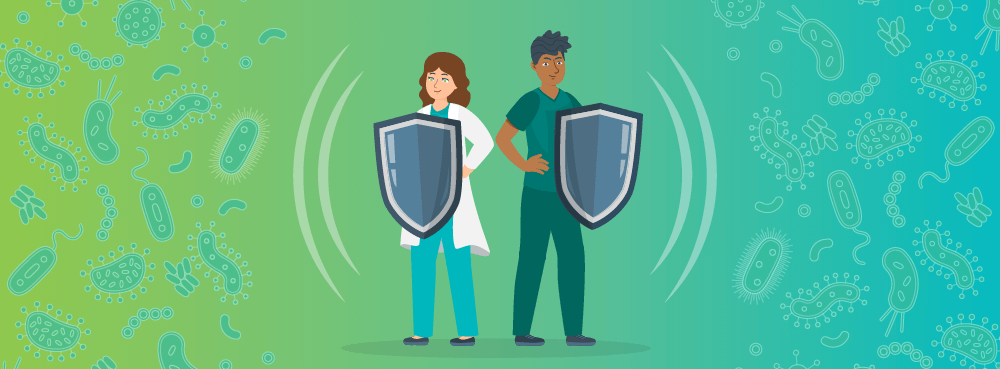The Culture of Infection Prevention and Control at a Healthcare Facility

The primary role of infection prevention and control (IPC) in healthcare settings is to reduce the risk of patients acquiring a healthcare-associated infection (HAI) and to protect patients and staff from transmission of pathogens.
It’s hard to imagine a time before dedicated IPC practices, but healthcare facilities did not always operate with infection control top of mind. This article will explore the origins of IPC practices and how the culture of infection prevention continues to shape hospital practices today.
TOPICS WE WILL COVER
1 / A brief history of IPC practices in healthcare
2 / IPC’s focus on decreasing healthcare-associated infections
3 / IPC practices required in healthcare settings
4 / Maintaining a culture of IPC is a team effort
A brief history of IPC practices in healthcare
The origins of IPC practices can be traced back to the 1800s. In 1846, Dr. Ignaz Semmelweis noted that basic hand hygiene by midwives decreased childbed fever among women who had delivered babies. Those insights led to the institution of a policy of hand washing before maternal contact, and the mortality rate among mothers dropped.
Similarly, in 1854, British physician John Snow discovered and eradicated the source of a cholera outbreak in London by applying statistics and epidemiology to his study. Once germ theory was understood, IPC practices became more prominent in healthcare.
IPC’s focus on decreasing healthcare-associated infections
While IPC continues to advance, it is a never-ending battle, and diligence in IPC is paramount to patient and staff safety. On any given day, about one in 31 hospital patients has at least one HAI.
Decreasing HAIs is a major objective of federal and state organizations. In 2009, the US Department of Health and Human Services published the National Action Plan to Prevent Health Care-Associated Infections: Road Map to Elimination. This document has been updated since then to identify areas for improvement in all healthcare settings.
Many healthcare organizations across the nation have mandates for public reporting of HAIs. This is decided at the state level; however, some infections have become reportable as a condition of participation in the Medicare program. The CDC has created a reporting system called the National Healthcare Safety Network (NHSN), which provides a standardized approach to surveillance of HAIs and other infection-related information.
IPC is a relevant part of all healthcare and has become increasingly important. Infection Preventionists (IP) are specially trained individuals from various healthcare backgrounds. The main goal is to promote a safety culture that positively impacts the health of patients, workers, staff, and community members.
IPs engage with all staff in healthcare and along the continuum of care. This includes nursing services, physicians/providers, housekeeping, maintenance, public health, volunteers, and pharmacists, to name a few.
IPC practices required in healthcare settings
The Centers for Disease Control and Prevention (CDC) has documented a core set of IPC practices required in all healthcare settings. Adhering to the core IPC practices will lead to a robust IPC culture for a healthcare organization/facility.
- Leadership support: Accountability from leadership regarding IPC activities is vital to a successful IPC program. Leaders should recognize and allocate appropriate resources to implement proper IPC strategies. It’s important to assign designated individual(s) to manage the IPC program.
- Education and training of healthcare personnel on IPC: IPC education should be required training for all those working in healthcare. Training should be completed on hire and as needed throughout the year, supplemented by written IPC policies and procedures to assist and guide workers in proper IPC strategies.
- Patient, family, and caregiver education: This includes information about how infections are spread, how they can be prevented, and what signs or symptoms should be reported.
- Performance monitoring and feedback: Identify and monitor adherence to IPC practices and give feedback to staff and leadership. Monitor the incidence of infections that could be an HAI.
- Standard precautions: these precautions emphasize and require basic practices that apply to all patient care, regardless of the patient’s suspected or confirmed infectious state, and apply to all settings where care is delivered. See the link for more information: Standard Precautions for All Patient Care
- Transmission-based precautions: Implement transmission-based precautions for patients with documented or suspected diagnoses where contact with the patient, their body fluids, or their environment presents a substantial transmission risk despite adherence to Standard Precautions. See link for more information: CDC Transmission-Based Precautions
- Temporary invasive medical devices for clinical management: Healthcare workers should assess the medical necessity of any invasive medical device (e.g., vascular catheter, indwelling urinary catheter, feeding tubes, ventilator, and surgical drain) to identify the earliest opportunity for safe removal.
- Occupational Health: Adhere to the Occupational Safety and Health Administration’s (OSHA) Bloodborne Pathogens Standard, Personal Protective Equipment Standard, Respiratory Protection Standard, and Tuberculosis (TB) compliance directives. See the link for more information: OSHA: Healthcare
The healthcare organization should ensure adherence to federal, state, and local requirements concerning immunizations; work policies that support the safety of healthcare personnel; timely reporting of illness by employees to employers; and public reporting, if applicable.
Maintaining a Culture of IPC is a Team Effort
It’s critical to remember that the IP is not the only one that performs IPC practices. All healthcare staff members are responsible for maintaining core practices.
Staff attitudes and values reflect the IPC culture in any healthcare organization. Recognizing staff’s knowledge of IPC best practices and exercising the correct processes and procedures can exhibit a positive IPC culture.
A non-punitive work environment is also conducive to encouraging a positive work environment. Frequent IPC rounds by those in charge of the IPC department and leadership will assist in identifying IPC breaches and opportunities for improvement. Patient and staff safety is the number one priority for any healthcare organization/facility. Infection prevention and control is everyone’s responsibility.
References:
- APIC. Who are infection preventionists. https://apic.org/monthly_alerts/who-are-infection-preventionists/
- CDC. 2022. Infection Control: CDC’s core infection prevention and control practices for safe healthcare delivery in all settings. https://www.cdc.gov/infectioncontrol/guidelines/core-practices/index.html
- CDC. 2016. Infection Control: Standard precautions for all patient care. https://www.cdc.gov/infectioncontrol/basics/standard-precautions.html
- CDC. 2016. Infection Control: Transmission-based precautions. https://www.cdc.gov/infectioncontrol/basics/transmission-based-precautions.html
- OSHA. Healthcare. https://www.osha.gov/healthcare
- Torriani, F., & Taplitz, R. (2010). History of infection prevention and control. Infectious Diseases, 76–85. https://doi.org/10.1016/B978-0-323-04579-7.00006-X
- U.S. Department of Health and Human Services. 2022. HAI national action plan. https://www.hhs.gov/oidp/topics/health-care-associated-infections/hai-action-plan/index.html#actionplan_development
Let's Talk!
Your time is valuable, and we don’t want to play hard to get. You can either phone us directly on the details listed on our contact page, or feel free to fill out this short form and one of our team members will get back to you as quickly as possible.
